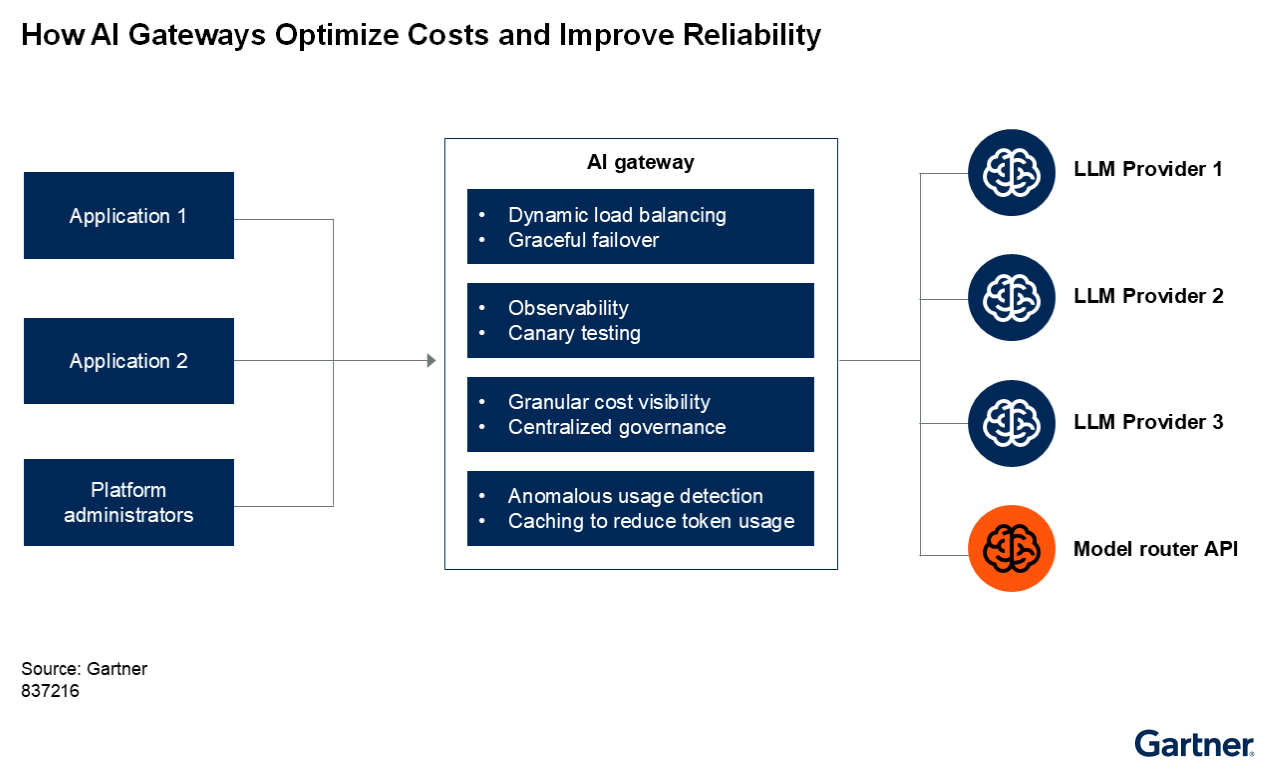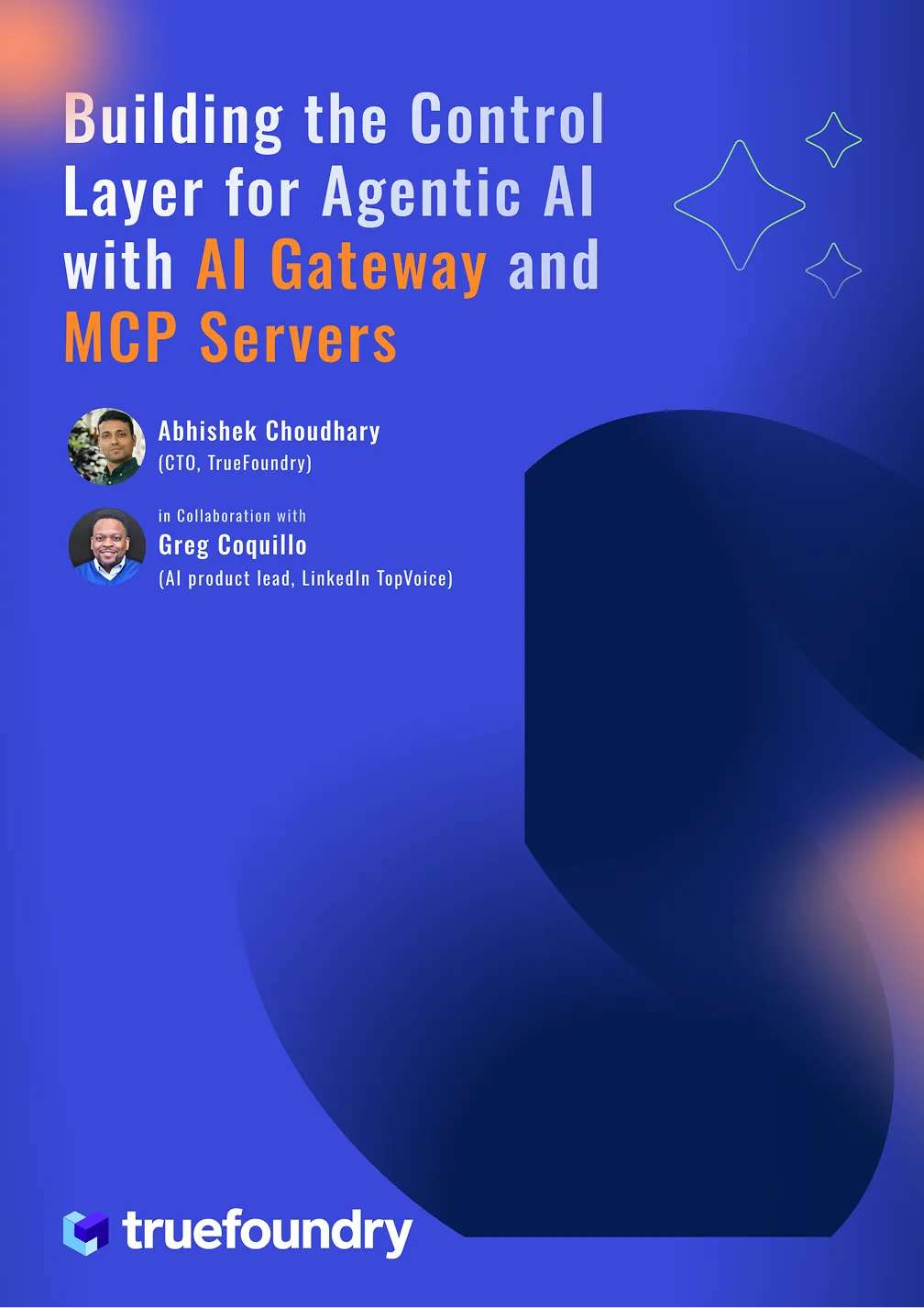Building the Enterprise AI Control Plane: Gartner Insights and TrueFoundry’s Approach
As enterprises scale their AI initiatives, a new challenge is emerging: uncontrolled costs, inconsistent governance, and fragmented integrations across models and providers. Gartner’s Market Guide for AI Gateways (October 2025) identifies this shift clearly, projecting that by 2028, 70% of software engineering teams building multimodel applications will use AI gateways to improve reliability and optimize costs, compared to 25% in 2025.
Gartner recognizes TrueFoundry AI Gateway as a representative vendor helping define this fast-evolving category. Built as a unified control layer for AI workloads, it brings observability, cost control, and governance to enterprise-scale AI environments.
Read the full report →https://www.gartner.com/en/documents/7051698
Understanding the AI Gateway Layer
Gartner defines an AI Gateway as middleware that sits between applications and AI services or models, managing security, observability, and cost optimization.
At a technical level, an AI Gateway performs four foundational tasks:
- Routing: Directs inference traffic to the most efficient model or provider according to latency, accuracy, or cost policies
- Security: Manages authentication, key rotation, and input or output guardrails from a central control point.
- Cost Control: Tracks token usage, enforces quotas, and applies caching to reduce redundant model calls
- Observability: Provides metrics, traces, and performance analytics across every AI interaction.
This transforms the Gateway into a programmable policy and governance plane sitting between the application layer and the model ecosystem — similar to what Kubernetes did for containers.
At TrueFoundry, we view this layer as the AI Control Plane — the layer that brings together reliability, accountability, and operational excellence for multimodel and multi-agent systems.
Inside Gartner’s Findings: Why AI Gateways Are Gaining Momentum
Gartner’s report identifies several forces accelerating AI Gateway adoption:
- Increasing traffic and token costs: Without centralized monitoring, organizations risk ungoverned AI usage. Gateways enable visibility, quota enforcement, and policy-driven spending.
- Security and compliance requirements: Gateways apply AI Trust, Risk, and Security Management (AI TRiSM) policies, ensuring safe prompts, data redaction, and regulated access.
- Expanding use cases: Initially designed for LLMs, Gateways are now expected to handle Model Context Protocol (MCP) and A2A (AI-to-AI) communication.
- Market immaturity: Capabilities vary widely between vendors. Gartner recommends choosing platforms with proven adaptability, innovation roadmaps, and strong integration capabilities.
In essence, Gateways are shifting from simple traffic routers to intelligent governance engines that define how enterprise AI operates.

What CIOs and Platform Teams Should Evaluate
Based on Gartner’s evaluation framework in the Market Guide for AI Gateways, enterprises should assess AI Gateway solutions on the following dimensions:
- Integration with Existing Systems: Compatibility with existing API gateways or service meshes without extensive re-architecture.
- Vendor Innovation Roadmap: Evidence of support for emerging standards such as MCP, A2A, and hybrid edge deployment.
- Security and Compliance Strength: Ability to safeguard credentials, block unsafe inputs, and maintain audit trails.
- Scalability and Latency Performance: Proven handling of high-throughput workloads while minimizing round-trip delays.
- Pricing Alignment: Transparent models that map to token consumption and enterprise budgeting cycles.
- Observability and Transparency: Built-in telemetry, cost analytics, and alerting for proactive governance.
- Integration with AI Security Tools: Compatibility with TRiSM or AI posture-management platforms to extend enterprise security coverage.
These considerations reflect a fundamental change in how organizations evaluate AI infrastructure: not only by accuracy or performance but by reliability, safety, and cost predictability.
How Enterprises Deploy Gateways
As enterprises operationalize AI Gateways, several deployment patterns are emerging across the market—each balancing central control with distributed performance.
Aggregator: A single gateway aggregates providers behind it, enforcing global policy and cross-model orchestration.
Proxy: Fronts individual providers for fast rollout of authentication and logging without re-architecture.
Composite / Hybrid: Regional gateways feed a global control layer for low-latency access under central governance.
These reflect the architectural flexibility Gartner emphasizes—supporting multi-cloud, hybrid, and on-prem models while maintaining unified governance and observability.
TrueFoundry AI Gateway supports all three: defaulting to Aggregator mode, scaling into Composite topologies for global rollouts, and offering Proxy setups for selective control.
How TrueFoundry AI Gateway Works
1. Unified Ingress and Routing Engine
The routing layer dynamically directs traffic based on performance, reliability, or cost criteria. It supports multiple AI providers such as OpenAI, Anthropic, Mistral, andCohere, and automatically fails over when a model or endpoint becomes unstable.
2. Token-Aware Cost Optimization
TrueFoundry’s adaptive cost engine tracks token consumption by application, user, and model. Semantic caching reduces redundant LLM requests by up to 40percent without sacrificing response quality, lowering spend and improving responsiveness.
3. Security and Guardrail Layer
Centralized key rotation eliminates credential sprawl. Input and output validation guardrails block unsafe prompts, redact sensitive data, and enforce compliance standards such as HIPAA and GDPR. Role-based and policy-based access control uses OAuth 2.x and OIDC for secure authentication.
4. Observability and Telemetry
Real-time tracing, latency analytics, and usage dashboards provide visibility into every AI interaction. Integrations with Grafana, Datadog, and OpenTelemetry allow unified monitoring across environments.
5. MCP Gateway Interoperability
TrueFoundry’s AI Gateway natively supports the Model Context Protocol, allowing AI agents to access enterprise systems through a secure, auditable control plane.This creates a seamless bridge between AI model governance and multi-agent orchestration.
Market Direction: The Shift from API to AI Management
Gartner notes a rapid convergence between API management and AI control systems. Traditional API vendors are adding AI-specific extensions, while AI platform providers like TrueFoundry deliver gateways that are natively optimized for token management, semantic caching, and latency analytics.
The total addressable market for AI Gateways is estimated at 50 to 100 million dollars in 2025, and it is expected to grow sharply as enterprises adopt multimodel and hybrid AI architectures. Gartner predicts increasing vendor consolidation, expansion into edge deployments, and deeper integration with AI observability tools.
Going Beyond Gartner’s Checklist
Gartner’s Market Guide lays out what enterprises should evaluate before adopting AI Gateways. TrueFoundry AI Gateway not only meets those criteria—it extends them with multi-provider routing, agent-aware governance, and deep observability
Here’s a snapshot of how TrueFoundry aligns with and goes beyond Gartner’s recommended capabilities.
This architecture enables platform and DevOps teams to operate AI systems with the same rigor they apply to production software; measurable, secure, and compliant.
To see the full enterprise checklist—including advanced criteria like multi-region deployments and MCP integration, download the AI Gateway Evaluation Checklist.
Value You Can Prove in 90 Days
Month 1: Centralize keys, activate token dashboards, and audit credentials for shadow usage.
Outcome: Cost visibility and credential security.
Month 2: Connect Identity Providers (Okta, Azure AD); enable quotas and budgets; roll out governance policies.
Outcome: Predictable spend and policy coverage.
Month 3: Activate routing, failover, and semantic caching to ensure uptime and cost optimization.
Outcome: High resilience and complete auditability.
Executive KPIs: Spend Predictability • Provider Resilience • Compliance Traceability
The Road Ahead
AI Gateways are becoming the backbone of enterprise AI, providing the governance and visibility needed to manage complex model ecosystems. Gartner’s 2025 Market Guide validates this shift and recognizes vendors such as TrueFoundry for advancing this essential layer of infrastructure.
As organizations evolve toward multimodel and multi-agent AI systems, TrueFoundry is focused on building the foundational control plane where routing, security, and cost management converge.
“The next phase of AI innovation will depend on how intelligently it is governed. AI Gateways make that governance possible.”
Learn more about TrueFoundry AI Gateway and how it enables secure, observable, and cost-efficient AI operations across any model or environment.
Built for Speed: ~10ms Latency, Even Under Load
Blazingly fast way to build, track and deploy your models!
- Handles 350+ RPS on just 1 vCPU — no tuning needed
- Production-ready with full enterprise support
TrueFoundry AI Gateway delivers ~3–4 ms latency, handles 350+ RPS on 1 vCPU, scales horizontally with ease, and is production-ready, while LiteLLM suffers from high latency, struggles beyond moderate RPS, lacks built-in scaling, and is best for light or prototype workloads.
























